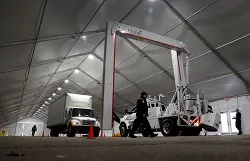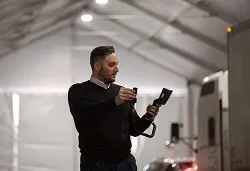As thousands of vehicles bring in the food, souvenirs, high-definition television equipment and

Office of Field Operations, officers conduct
non-intrusive inspections on commercial
vehicles destined for U.S. Bank Stadium to
deliver provisions and equipment for Super
Bowl LII in Minneapolis, Minnesota,
Jan. 30, 2018. Photo by Glenn Fawcett
fans to celebrate this year’s Super Bowl in Minneapolis, Minnesota, U.S. Customs and Border Protection is making sure no one – and no thing – comes in that’s not supposed to.
“We scan vehicles coming in for explosives, weapons and anything that might look out of place,’” said James Askin, a CBP officer from the Port of Newark, New Jersey, working as a non-intrusive inspection equipment operator in the back of a giant X-ray truck under a tent at the Minnesota State Fairgrounds, just a few miles from the stadium. “Nothing gets in without our thumbs-up.”
It’s a process made quicker and easier with CBP’s non-intrusive inspection equipment: The Vehicle and Cargo Inspection System, better known as VACIS, and the Z-Backscatter Van. VACIS is a large X-ray machine for semitrailers while Backscatter is a smaller and more mobile version of the same technology to scan personal vehicles, delivery vans and recreational vehicles.
“These machines basically take an X-ray of a vehicle,” said Gerald Durand, a CBP watch commander at the Minneapolis Service Port. “That saves us a great deal of time, allowing us to search each vehicle in just 7-10 minutes,” an important aspect when you consider the hundreds of vehicles that the port of entry checks every day.
VACIS scans both sides of large items, including semis and cargo containers and usually is used at ports of entry. It’s able to detect anything from big, hidden compartments down to small packages or even something as small as a handgun. It even picks up people being smuggled in a trailer or vehicle.
Backscatter does basically the same thing, but fits in a box on the back of a truck and scans just one side of a vehicle. It works well in the cold, an important factor considering the Super Bowl’s cold weather location this year. Durand said both systems’ effectiveness is a reflection of the skills of their three to five-person crews of operators, drivers and guides.
“The operators and their experience – knowing what to look for and knowing what doesn’t look right – really makes the difference in identifying what’s in a shipment,” he said, adding that once some kind of anomaly is found, it’s up to CBP officers on the ground to dig in and find it.

Office of Field Operations, Officer Anthony
Hallmark reviews an X-ray image of a truck
that was just scanned during non-intrusive
inspections on commercial vehicles destined
for U.S. Bank Stadium prior to Super Bowl
LII in Minneapolis, Minnesota, Jan. 30, 2018.
Photo by Glenn Fawcett
On this day, Askin sees something that’s not quite right, just behind the cab of a tractor-trailer coming through. It shows up on the screen in front of him as a dark anomaly. Askin has another member of the team check out the dark spot by digging into the actual spot on the vehicle. This time, it turned out just to be some tools and a warning triangle the trucker carries with him for emergencies. The trained eyes of the officers – made faster and more efficient by the high-tech equipment – provide a layer of defense that helps peel away the layers of cargo without spending hours digging into each and every vehicle, an unfeasible prospect considering the thousands of vehicles coming through.
“We’re trained to find anything out of the ordinary,” said Rose Wood, a supervisory CBP officer who’s trekked from the much warmer climate of El Paso, Texas, to a considerably colder Minneapolis. “We and our equipment work in all weather.”
Another important part of the process is keeping the crews and public safe from the large doses of X-rays used to peer into the trucks, trailers and recreational vehicles coming through the screening process. Mark Jadick, a CBP central team health physicist from Seattle, Washington,

Protection Occupational Health and Safety
uses a radiation detector to ensure officer
and public safety as a truck is scanned
during non-intrusive inspections on
commercial vehicles destined for U.S. Bank
Stadium to deliver provisions and equipment
for Super Bowl LII in Minneapolis, Minnesota,
Jan. 30, 2018.Photo by Glenn Fawcett
walked around the search site with a handheld piece of equipment called a GM probe to make sure no one is getting overdosed.
“We have well-established control boundaries set up in the tent,” he said. “These operators are excellent and know what they are doing. My job is to provide a final check before we get any operations going. Everything is operating smoothly and safely, as it should be.”
In addition, Jadick carried another handheld device called a RadSeeker, which measures for any radiation coming from the cargo. “If we pick up radiation after VACIS is off, RadSeeker can tell us why,” said Jadick.
Durand said for the dozens of CBP personnel operating the non-intrusive inspection equipment at the Super Bowl, it’s valuable experience.
“Any time they get to see anything different from their routine, it’s always going to help their abilities to do their jobs,” said Durand.
Once CBP has done its job, the vehicles are handed off to National Guard and law enforcement assets for escort to the stadium.
For Askin, the task at the Super Bowl in many ways is much like his regular job back at the Port of Newark. But he said it’s a bit more challenging since, this time, they don’t have the typical manifests that usually accompany the cargo. But he credits his team members for making it all work.
“CBP Officer Gilbert Longoria, the VACIS driver, is from Houston; I’m from Newark. I just met him two days ago, but we’re already on the same page,” said Askin. “We’ve got guys from all over the country, but everyone knows what they’re doing. It really shows a good aspect of CBP teamwork.”


